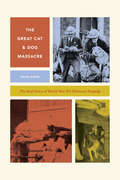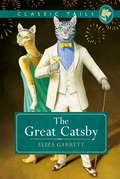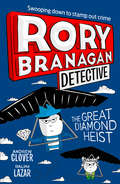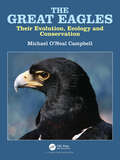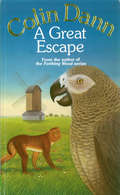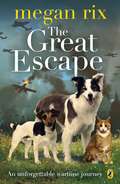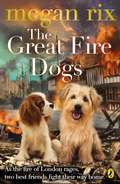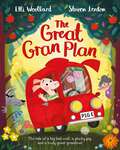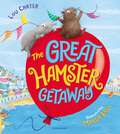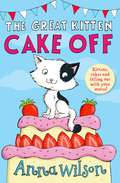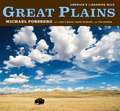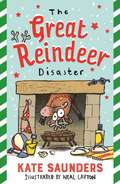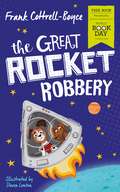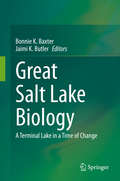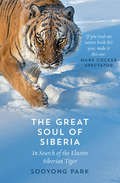- Table View
- List View
The Great Cat and Dog Massacre: The Real Story of World War Two's Unknown Tragedy (Animal Lives)
by Hilda KeanThe tragedies of World War II are well known. But at least one has been forgotten: in September 1939, four hundred thousand cats and dogs were massacred in Britain. The government, vets, and animal charities all advised against this killing. So why would thousands of British citizens line up to voluntarily euthanize household pets? In The Great Cat and Dog Massacre, Hilda Kean unearths the history, piecing together the compelling story of the life—and death—of Britain’s wartime animal companions. She explains that fear of imminent Nazi bombing and the desire to do something to prepare for war led Britons to sew blackout curtains, dig up flower beds for vegetable patches, send their children away to the countryside—and kill the family pet, in theory sparing them the suffering of a bombing raid. Kean’s narrative is gripping, unfolding through stories of shared experiences of bombing, food restrictions, sheltering, and mutual support. Soon pets became key to the war effort, providing emotional assistance and helping people to survive—a contribution for which the animals gained government recognition. Drawing extensively on new research from animal charities, state archives, diaries, and family stories, Kean does more than tell a virtually forgotten story. She complicates our understanding of World War II as a “good war” fought by a nation of “good” people. Accessibly written and generously illustrated, Kean’s account of this forgotten aspect of British history moves animals to center stage—forcing us to rethink our assumptions about ourselves and the animals with whom we share our homes.
The Great Cat and Dog Massacre: The Real Story of World War Two's Unknown Tragedy (Animal Lives)
by Hilda KeanThe tragedies of World War II are well known. But at least one has been forgotten: in September 1939, four hundred thousand cats and dogs were massacred in Britain. The government, vets, and animal charities all advised against this killing. So why would thousands of British citizens line up to voluntarily euthanize household pets? In The Great Cat and Dog Massacre, Hilda Kean unearths the history, piecing together the compelling story of the life—and death—of Britain’s wartime animal companions. She explains that fear of imminent Nazi bombing and the desire to do something to prepare for war led Britons to sew blackout curtains, dig up flower beds for vegetable patches, send their children away to the countryside—and kill the family pet, in theory sparing them the suffering of a bombing raid. Kean’s narrative is gripping, unfolding through stories of shared experiences of bombing, food restrictions, sheltering, and mutual support. Soon pets became key to the war effort, providing emotional assistance and helping people to survive—a contribution for which the animals gained government recognition. Drawing extensively on new research from animal charities, state archives, diaries, and family stories, Kean does more than tell a virtually forgotten story. She complicates our understanding of World War II as a “good war” fought by a nation of “good” people. Accessibly written and generously illustrated, Kean’s account of this forgotten aspect of British history moves animals to center stage—forcing us to rethink our assumptions about ourselves and the animals with whom we share our homes.
The Great Cat and Dog Massacre: The Real Story of World War Two's Unknown Tragedy (Animal Lives)
by Hilda KeanThe tragedies of World War II are well known. But at least one has been forgotten: in September 1939, four hundred thousand cats and dogs were massacred in Britain. The government, vets, and animal charities all advised against this killing. So why would thousands of British citizens line up to voluntarily euthanize household pets? In The Great Cat and Dog Massacre, Hilda Kean unearths the history, piecing together the compelling story of the life—and death—of Britain’s wartime animal companions. She explains that fear of imminent Nazi bombing and the desire to do something to prepare for war led Britons to sew blackout curtains, dig up flower beds for vegetable patches, send their children away to the countryside—and kill the family pet, in theory sparing them the suffering of a bombing raid. Kean’s narrative is gripping, unfolding through stories of shared experiences of bombing, food restrictions, sheltering, and mutual support. Soon pets became key to the war effort, providing emotional assistance and helping people to survive—a contribution for which the animals gained government recognition. Drawing extensively on new research from animal charities, state archives, diaries, and family stories, Kean does more than tell a virtually forgotten story. She complicates our understanding of World War II as a “good war” fought by a nation of “good” people. Accessibly written and generously illustrated, Kean’s account of this forgotten aspect of British history moves animals to center stage—forcing us to rethink our assumptions about ourselves and the animals with whom we share our homes.
The Great Cat and Dog Massacre: The Real Story of World War Two's Unknown Tragedy (Animal Lives)
by Hilda KeanThe tragedies of World War II are well known. But at least one has been forgotten: in September 1939, four hundred thousand cats and dogs were massacred in Britain. The government, vets, and animal charities all advised against this killing. So why would thousands of British citizens line up to voluntarily euthanize household pets? In The Great Cat and Dog Massacre, Hilda Kean unearths the history, piecing together the compelling story of the life—and death—of Britain’s wartime animal companions. She explains that fear of imminent Nazi bombing and the desire to do something to prepare for war led Britons to sew blackout curtains, dig up flower beds for vegetable patches, send their children away to the countryside—and kill the family pet, in theory sparing them the suffering of a bombing raid. Kean’s narrative is gripping, unfolding through stories of shared experiences of bombing, food restrictions, sheltering, and mutual support. Soon pets became key to the war effort, providing emotional assistance and helping people to survive—a contribution for which the animals gained government recognition. Drawing extensively on new research from animal charities, state archives, diaries, and family stories, Kean does more than tell a virtually forgotten story. She complicates our understanding of World War II as a “good war” fought by a nation of “good” people. Accessibly written and generously illustrated, Kean’s account of this forgotten aspect of British history moves animals to center stage—forcing us to rethink our assumptions about ourselves and the animals with whom we share our homes.
The Great Cat and Dog Massacre: The Real Story of World War Two's Unknown Tragedy (Animal Lives)
by Hilda KeanThe tragedies of World War II are well known. But at least one has been forgotten: in September 1939, four hundred thousand cats and dogs were massacred in Britain. The government, vets, and animal charities all advised against this killing. So why would thousands of British citizens line up to voluntarily euthanize household pets? In The Great Cat and Dog Massacre, Hilda Kean unearths the history, piecing together the compelling story of the life—and death—of Britain’s wartime animal companions. She explains that fear of imminent Nazi bombing and the desire to do something to prepare for war led Britons to sew blackout curtains, dig up flower beds for vegetable patches, send their children away to the countryside—and kill the family pet, in theory sparing them the suffering of a bombing raid. Kean’s narrative is gripping, unfolding through stories of shared experiences of bombing, food restrictions, sheltering, and mutual support. Soon pets became key to the war effort, providing emotional assistance and helping people to survive—a contribution for which the animals gained government recognition. Drawing extensively on new research from animal charities, state archives, diaries, and family stories, Kean does more than tell a virtually forgotten story. She complicates our understanding of World War II as a “good war” fought by a nation of “good” people. Accessibly written and generously illustrated, Kean’s account of this forgotten aspect of British history moves animals to center stage—forcing us to rethink our assumptions about ourselves and the animals with whom we share our homes.
The Great Catsby: Beautifully illustrated classics, as told by the finest breeds! (Classic Tails)
by Eliza GarrettCLASSIC TAILS - the greatest works of literature, as told by the finest breedsWe all have our favourite classic tales; books that have been beloved to us since childhood, whose wonderful stories and rich tapestry of characters are unsurpassed in modern literature. How, you may ask, could these marvellous works ever be improved upon?Reader, ask no more...for we present The Great CatsbyMillionaire Jay Catsby is a mystery. All alone in his moggy mansion, he throws extravagant parties attended by all the great and the good of the feline world. What nobody knows is that this is a kitty haunted by love - the love of a beautiful pussycat called Daisy, whom he lost to another long ago - and Catsby's great wish is that one day she, too, might be drawn to join the festivities.When Daisy's cousin Nick moves in next door, it seems like Catsby is a whisker away from winning back his beloved. But Daisy's husband Tomcat has other ideas...What readers are saying about The Great Catsby:'Hilarious twist on a classic, filled with many much appreciated cat puns''A lovely feline version of the classic tale. Beautiful and cute images and a lot of funny cat references!''Fun book - cleverly written. 5 stars'
Great Crested Newt (Large Print)
This is a picture of a Great Crested Newt viewed from the side and facing to the left. There is a locator dot shown, which will be at the top left of the page when the image is the right way up. On the far left is the newt's head with its mouth and one eye visible. The newt's body is to the right with a crest running along the top to the tail at the far right. The newt's legs can be found down from its body towards the bottom of the page. The two front legs, on the left, have four toes, while the back legs, on the right, have five. There are dark patches all over the newt's body and legs.
Great Crested Newt (UEB Contracted)
This is a picture of a Great Crested Newt viewed from the side and facing to the left. There is a locator dot shown, which will be at the top left of the page when the image is the right way up. On the far left is the newt's head with its mouth and one eye visible. The newt's body is to the right with a crest running along the top to the tail at the far right. The newt's legs can be found down from its body towards the bottom of the page. The two front legs, on the left, have four toes, while the back legs, on the right, have five. There are dark patches all over the newt's body and legs.
Great Crested Newt (UEB uncontracted)
This is a picture of a Great Crested Newt viewed from the side and facing to the left. There is a locator dot shown, which will be at the top left of the page when the image is the right way up. On the far left is the newt's head with its mouth and one eye visible. The newt's body is to the right with a crest running along the top to the tail at the far right. The newt's legs can be found down from its body towards the bottom of the page. The two front legs, on the left, have four toes, while the back legs, on the right, have five. There are dark patches all over the newt's body and legs.
The Great Diamond Heist (Rory Branagan (Detective) #7)
by Andrew CloverHello. I am Rory Branagan. I am a DETECTIVE, and the time has come for me to solve the BIGGEST and most IMPORTANT mystery in my life: where is my Dad?
The Great Eagles: Their Evolution, Ecology and Conservation
by Michael O'Neal CampbellThis book examines the current literature and knowledge on the evolution and ecology of all the birds named as eagles, with particular emphasis on the larger species. It also examines the past and current relations between eagles and people, including habitat change and conservation issues. Eagle ecologies and conservation are currently seriously impacted by human activities such as industrialization, urbanization, pollution, deforestation and hunting. Some eagle species have consequently experienced extreme population changes. There are, however, some positive developments. Eagles have a strong, historic bond with human civilization, due to their status as the world’s most charismatic birds. Conservation policies have also been successful in repopulating some ecosystems with breeding eagles. Therefore, despite the complexity of this relationship, there may yet be hope for this unique species group, frequently rated as the kings of birds, and symbolic of human power, ambition, royalty, nationality, and even concepts of God. It is hoped that this book will contribute to the further understanding of these unique and fantastic birds.
The Great Eagles: Their Evolution, Ecology and Conservation
by Michael O'Neal CampbellThis book examines the current literature and knowledge on the evolution and ecology of all the birds named as eagles, with particular emphasis on the larger species. It also examines the past and current relations between eagles and people, including habitat change and conservation issues. Eagle ecologies and conservation are currently seriously impacted by human activities such as industrialization, urbanization, pollution, deforestation and hunting. Some eagle species have consequently experienced extreme population changes. There are, however, some positive developments. Eagles have a strong, historic bond with human civilization, due to their status as the world’s most charismatic birds. Conservation policies have also been successful in repopulating some ecosystems with breeding eagles. Therefore, despite the complexity of this relationship, there may yet be hope for this unique species group, frequently rated as the kings of birds, and symbolic of human power, ambition, royalty, nationality, and even concepts of God. It is hoped that this book will contribute to the further understanding of these unique and fantastic birds.
A Great Escape
by Colin DannEric made up his mind. He would go to the pet shop, open the cages and let the little troupe of animals free, to make their own way in the world. And so began A Great Escape.
The Great Escape
by Megan RixThe Great Escape is a gripping and heartwarming story for 9+ readers about three pets who are separately from their beloved owners in Second World War London, fleeing to the countryside to survive.Perfect for fans of Michael Morpurgo's War Horse and Lauren St John.BUSTER is a lively Jack RussellTIGER is a feisty white and ginger tomROSE is a faithful Collie Robert and Lucy Edwards love their pets more than anything; but the threat of the Second World War forces them to flee to Devon - leaving their animals behind. And as the air raid sirens sound over London, the frightened animals are sent to be put down.Buster, Tiger and Rose make a daring escape but with danger at every turn, can the trio make it across the country as it prepares for battle - and cheat death for the second time?Praise for Megan Rix:'If you love Michael Morpurgo, you will enjoy this' Express 'A moving tale told with warmth, kindliness and lashings of good sense that lovers of Dick King-Smith will especially appreciate' The Times'Every now and then a writer comes along with a unique way of storytelling . . . Meet Megan Rix . . . her novels are deeply moving and will strike a chord with animal lovers.' LoveReadingAbout the author:Megan Rix lives in England with her husband, and their adorable dogs, Traffy and Bella. Also available by Megan Rix:The Great Escape, The Victory Dogs.www.meganrix.com
The Great Fire Dogs
by Megan RixLondon 1666 - A terrible plague has swept through the city and people live in fear of animals carrying the disease.Woofer is a loveable stray who works in the palace kitchen and Tiger Lily is the pampered pet spaniel of King Charles II. They come from very different worlds but this hasn't stopped them becoming the best of friends and looking out for each other. When Woofer finds himself in trouble he has to escape the palace grounds and Tiger Lily isn't far behind him.It's not long before a new danger emerges - a great fire is sweeping across London destroying everything in its path. Can these two brave dogs survive the blazing fire and make their way to safety?
The Great Gran Plan
by Elli WoollardThe pig lives in a house in the middle of the wild wood.But inside the wild wood there's a bad wolf - and this hungry wolf wants a little pig for dinner! But a house made of bricks is hard to blow down, so instead of gobbling Pig, Wolf moves to plan B: gobbling Red Riding Hood's poor defenceless grandma! But his despicable plan is soon uncovered and Pig decides to rescue Gran! Will this plucky pig make it in time? A fabulously funny twist on two classic fairy tales: Little Red Riding Hood and The Three Little Pigs. The Great Gran Plan is the first book by an exciting picture book pairing: the uniquely talented author and poet, Elli Woollard and best-selling illustrator, Steven Lenton.
The Great Hamster Getaway
by Lou CarterRaffleton Grey is as BORED as a hamster can be. He wants to go to the fair – but he's STUCK in his cage.There's only one thing for it . . . Get ready for the most exciting HAMSTER GETAWAY in history!Freedom means new friendships and tasty ice cream and fairground rides. But as night falls, things begin to get a bit scary. Perhaps home isn't so bad after all – especially if you have a new friend by your side . . .This hilarious rhyming adventure is perfect for reading (and laughing!) out loud – a fun-packed summertime getaway that's irresistible to readers both big and small!
The Great Kitten Cake Off
by Anna WilsonEllie Haines despairs of her family. Her younger brother is so desperate to be on TV he's tried everything from sending films of his hamster to SpringwatchLive to auditioning Mum for Looking Good Naked (urgh!). Mum appears to be going through some kind of midlife crisis and Dad's bad 'yolks' have reached alarming new 'egg-stremes'.The only bright spots in Ellie's life are her naughty kitten, Kitkat, and her best mate, Mads. But when Mads and Ellie apply for The Junior Cake Off, their friendship soon starts to crumble. It doesn't help that the gorgeous Ted Watson has caught Mads's eye, too . . . Can Ellie win back her best mate, or will their friendship go up in smoke?
Great Plains: America's Lingering Wild
by Michael ForsbergThe Great Plains were once among the greatest grasslands on the planet. But as the United States and Canada grew westward, the Plains were plowed up, fenced in, overgrazed, and otherwise degraded. Today, this fragmented landscape is the most endangered and least protected ecosystem in North America. But all is not lost on the prairie. Through lyrical photographs, essays, historical images, and maps, this beautifully illustrated book gets beneath the surface of the Plains, revealing the lingering wild that still survives and whose diverse natural communities, native creatures, migratory traditions, and natural systems together create one vast and extraordinary whole. Three broad geographic regions in Great Plains are covered in detail, evoked in the unforgettable and often haunting images taken by Michael Forsberg. Between the fall of 2005 and the winter of 2008, Forsberg traveled roughly 100,000 miles across 12 states and three provinces, from southern Canada to northern Mexico, to complete the photographic fieldwork for this project, underwritten by The Nature Conservancy. Complementing Forsberg’s images and firsthand accounts are essays by Great Plains scholar David Wishart and acclaimed writer Dan O’Brien. Each section of the book begins with a thorough overview by Wishart, while O’Brien—a wildlife biologist and rancher as well as a writer—uses his powerful literary voice to put the Great Plains into a human context, connecting their natural history with man’s uses and abuses. The Great Plains are a dynamic but often forgotten landscape—overlooked, undervalued, misunderstood, and in desperate need of conservation. This book helps lead the way forward, informing and inspiring readers to recognize the wild spirit and splendor of this irreplaceable part of the planet.
Great Plains: America's Lingering Wild
by Michael ForsbergThe Great Plains were once among the greatest grasslands on the planet. But as the United States and Canada grew westward, the Plains were plowed up, fenced in, overgrazed, and otherwise degraded. Today, this fragmented landscape is the most endangered and least protected ecosystem in North America. But all is not lost on the prairie. Through lyrical photographs, essays, historical images, and maps, this beautifully illustrated book gets beneath the surface of the Plains, revealing the lingering wild that still survives and whose diverse natural communities, native creatures, migratory traditions, and natural systems together create one vast and extraordinary whole. Three broad geographic regions in Great Plains are covered in detail, evoked in the unforgettable and often haunting images taken by Michael Forsberg. Between the fall of 2005 and the winter of 2008, Forsberg traveled roughly 100,000 miles across 12 states and three provinces, from southern Canada to northern Mexico, to complete the photographic fieldwork for this project, underwritten by The Nature Conservancy. Complementing Forsberg’s images and firsthand accounts are essays by Great Plains scholar David Wishart and acclaimed writer Dan O’Brien. Each section of the book begins with a thorough overview by Wishart, while O’Brien—a wildlife biologist and rancher as well as a writer—uses his powerful literary voice to put the Great Plains into a human context, connecting their natural history with man’s uses and abuses. The Great Plains are a dynamic but often forgotten landscape—overlooked, undervalued, misunderstood, and in desperate need of conservation. This book helps lead the way forward, informing and inspiring readers to recognize the wild spirit and splendor of this irreplaceable part of the planet.
The Great Reindeer Disaster
by Kate SaundersJingle bells, Jingle bells, smelly poo and bum!You can wait for Christmas but it's never going to come!When a miniature reindeer named Percy falls down the chimney of the Trubshaws' holiday cottage, the last thing they expect is to be whisked away to the distant planet of Yule-1 - the REAL home of Father Christmas, the elves, and his intrepid reindeer delivery teams. And what an amazing place it is - nobody minds being stuck there until the computer system has been mended.But the festive season is in danger! One rogue reindeer has teamed up with the evil Krampus to sabotage everything. Unless Percy and his new friends can track them down, there will be no Christmas this year - or EVER AGAIN!Illustrated in black and white by Neal Layton, this is destined to become a holiday favourite.
The Great Rocket Robbery: World Book Day 2019
by Frank Cottrell BoyceLaika and her fellow street dogs are being trained up for the greatest adventure in history – a trip to the moon! But Laika can't wait to see the stars – so she hatches a plan with her friends to get her there all on her own . . .Join Laika and friends in The Great Rocket Robbery by Carnegie Medal-winning author Frank Cottrell-Boyce, illustrated by Steven Lenton – final destination: adventure!
Great Salt Lake Biology: A Terminal Lake in a Time of Change
by Bonnie K. Baxter Jaimi K. ButlerGreat Salt Lake is an enormous terminal lake in the western United States. It is a highly productive ecosystem, which has global significance for millions of migrating birds who rely on this critical feeding station on their journey through the American west. For the human population in the adjacent metropolitan area, this body of water provides a significant economic resource as industries, such as brine shrimp harvesting and mineral extraction, generate jobs and income for the state of Utah. In addition, the lake provides the local population with ecosystem services, especially the creation of mountain snowpack that generates water supply, and the prevention of dust that may impair air quality. As a result of climate change and water diversions for consumptive uses, terminal lakes are shrinking worldwide, and this edited volume is written in this urgent context. This is the first book ever centered on Great Salt Lake biology. Current and novel data presented here paint a comprehensive picture, building on our past understanding and adding complexity. Together, the authors explore this saline lake from the microbial diversity to the invertebrates and the birds who eat them, along a dynamic salinity gradient with unique geochemistry. Some unusual perspectives are included, including the impact of tar seeps on the lake biology and why Great Salt Lake may help us search for life on Mars. Also, we consider the role of human perceptions and our effect on the biology of the lake. The editors made an effort to involve a diversity of experts on the Great Salt Lake system, but also to include unheard voices such as scientists at state agencies or non-profit advocacy organizations. This book is a timely discussion of a terminal lake that is significant, unique, and threatened.
The Great Soul of Siberia: Passion, Obsession, And One Man's Quest For The World's Most Elusive Tiger
by Sooyong ParkThere are five races of tiger on our planet and all but one live in tropical regions: the Siberian Tiger Panthera tigris altaica is the exception. Mysterious and elusive, and with only 350 remaining in the wild, the Siberian tiger remains a complete enigma. One man has set out to change this.
Great White Shark (Large Print)
This is an image of a great white shark viewed from the side. There is a locator dot shown, which will be at the top left of the page when the image is the right way up. The shark's pointed snout is at the centre left of the page, and just beneath this its mouth is wide open to reveal very sharp teeth. Only one eye is visible, and to the right of the mouth there is one set of gill slits.The shark has a torpedo-shaped body, with its tail at the right of the page. The dorsal fin sticks up from the middle of the shark's back, with a smaller fin near the tail. On the lower side of its body, only one of the pectoral fins can be seen halfway along the body, with another small fin near the tail.
